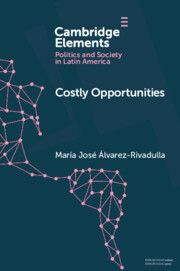Refine search
Actions for selected content:
136 results
5 - ‘Actively Preparing Children for New Conflicts’
-
- Book:
- Governing the Past
- Published online:
- 30 July 2025
- Print publication:
- 07 August 2025, pp 124-151
-
- Chapter
- Export citation
4 - Madras
-
- Book:
- Land, Law and Empire
- Published online:
- 01 September 2025
- Print publication:
- 07 August 2025, pp 101-146
-
- Chapter
- Export citation
10 - A Southern Ambiance
-
- Book:
- A Black Army
- Published online:
- 16 June 2025
- Print publication:
- 17 July 2025, pp 186-207
-
- Chapter
- Export citation
Introduction: An Experiment in Race Relations
-
- Book:
- A Black Army
- Published online:
- 16 June 2025
- Print publication:
- 17 July 2025, pp 1-14
-
- Chapter
- Export citation

A Black Army
- Segregation and the US Military at Fort Huachuca, Arizona, 1941–1945
-
- Published online:
- 16 June 2025
- Print publication:
- 17 July 2025
Reforming Segregation through the Perspectives of Correctional Officers
-
- Journal:
- Canadian Journal of Law & Society / La Revue Canadienne Droit et Société / Volume 40 / Issue 1 / April 2025
- Published online by Cambridge University Press:
- 13 June 2025, pp. 48-69
-
- Article
-
- You have access
- Open access
- HTML
- Export citation
17 - Antisemitic Policy in the Early Years of the Third Reich
-
-
- Book:
- The Cambridge History of the Holocaust
- Published online:
- 16 May 2025
- Print publication:
- 12 June 2025, pp 351-372
-
- Chapter
- Export citation
12 - Ghettos and Other Confined Spaces of Jewish Life in Nazi-Dominated Europe
- from Part II - Times and Places
-
-
- Book:
- The Cambridge History of the Holocaust
- Published online:
- 21 May 2025
- Print publication:
- 12 June 2025, pp 291-312
-
- Chapter
- Export citation
Polarisation and inequality: ‘peace’ in Northern Ireland
-
- Journal:
- Journal of Social Policy , First View
- Published online by Cambridge University Press:
- 31 March 2025, pp. 1-23
-
- Article
-
- You have access
- Open access
- HTML
- Export citation
Chapter 10 - Disfranchisement, Segregation, and the Rise of African American Literature
- from Part II - Issues
-
-
- Book:
- The Cambridge Companion to Nineteenth-Century American Literature and Politics
- Published online:
- 06 March 2025
- Print publication:
- 13 March 2025, pp 178-189
-
- Chapter
- Export citation
4 - Black Homesteading and the Dearfield Colony
-
- Book:
- American Grasslands
- Published online:
- 06 February 2025
- Print publication:
- 13 February 2025, pp 62-77
-
- Chapter
- Export citation
3 - The United States
- from Equality
-
- Book:
- Constitutionalizing the Private Sphere
- Published online:
- 23 January 2025
- Print publication:
- 06 February 2025, pp 63-100
-
- Chapter
- Export citation
16 - The Segregation of Belief: How Structure Facilitates False Consensus
- from Part IV - Society
-
- Book:
- Behavioral Network Science
- Published online:
- 08 November 2024
- Print publication:
- 19 December 2024, pp 258-277
-
- Chapter
- Export citation
7 - An American Elegy
- from Part III - Understanding Slavery, Race, and Inequality in the American South
-
- Book:
- Understanding the American South
- Published online:
- 05 December 2024
- Print publication:
- 12 December 2024, pp 169-191
-
- Chapter
- Export citation

Costly Opportunities
- Social Mobility in Segregated Societies
-
- Published online:
- 01 May 2024
- Print publication:
- 30 May 2024
-
- Element
- Export citation
15 - The South African Landownership Struggle
- from Part III - Sustainable Urban Planning in Africa
-
-
- Book:
- Reimagining Urban Planning in Africa
- Published online:
- 07 December 2023
- Print publication:
- 21 December 2023, pp 261-281
-
- Chapter
- Export citation
5 - Civil Rights and Race in the United States
- from Part II - Political Rhetoric in Practice
-
- Book:
- Political Rhetoric in Theory and Practice
- Published online:
- 02 November 2023
- Print publication:
- 16 November 2023, pp 159-178
-
- Chapter
- Export citation
43 - The Equal Protection Clause and Race
- from Part VIII - Labor, Equal Protection, and Race
-
- Book:
- The Taft Court
- Published online:
- 19 October 2023
- Print publication:
- 09 November 2023, pp 1430-1493
-
- Chapter
- Export citation
2 - The Britishers
-
- Book:
- Multiracial Britishness
- Published online:
- 19 October 2023
- Print publication:
- 02 November 2023, pp 53-89
-
- Chapter
- Export citation
Rodriguez at Fifty: A Legacy of Intersecting Inequalities
-
- Journal:
- History of Education Quarterly / Volume 63 / Issue 4 / November 2023
- Published online by Cambridge University Press:
- 15 November 2023, pp. 444-466
- Print publication:
- November 2023
-
- Article
-
- You have access
- Open access
- HTML
- Export citation
